Part Ⅱ Using language——动词不定式作定语和结果状语
- 格式:ppt
- 大小:4.13 MB
- 文档页数:10
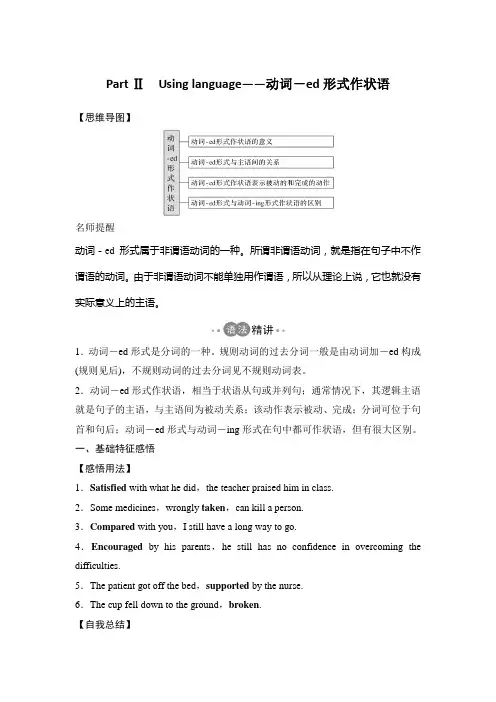
Part ⅡUsing language——动词-ed形式作状语【思维导图】名师提醒动词-ed形式属于非谓语动词的一种。
所谓非谓语动词,就是指在句子中不作谓语的动词。
由于非谓语动词不能单独用作谓语,所以从理论上说,它也就没有实际意义上的主语。
1.动词-ed形式是分词的一种。
规则动词的过去分词一般是由动词加-ed构成(规则见后),不规则动词的过去分词见不规则动词表。
2.动词-ed形式作状语,相当于状语从句或并列句;通常情况下,其逻辑主语就是句子的主语,与主语间为被动关系;该动作表示被动、完成;分词可位于句首和句后;动词-ed形式与动词-ing形式在句中都可作状语,但有很大区别。
一、基础特征感悟【感悟用法】1.Satisfied with what he did,the teacher praised him in class.2.Some medicines,wrongly taken,can kill a person.3.Compared with you,I still have a long way to go.4.Encouraged by his parents,he still has no confidence in overcoming the difficulties.5.The patient got off the bed,supported by the nurse.6.The cup fell down to the ground,broken.【自我总结】1.所有句子中动词-ed形式都作状语,其逻辑主语都是句子的主语,与主语间为被动含义。
2.动词-ed形式的位置可以在句子开头、中间和末尾。
3.以上句子中的动词-ed形式分别作原因、时间、条件、让步、方式、结果状语。
二、主要用法精讲【重点归纳】1.动词-ed形式作状语的意义动词-ed形式作状语来源于状语从句或并列句。
可以表示时间、原因、条件、让步、方式或伴随情况等。
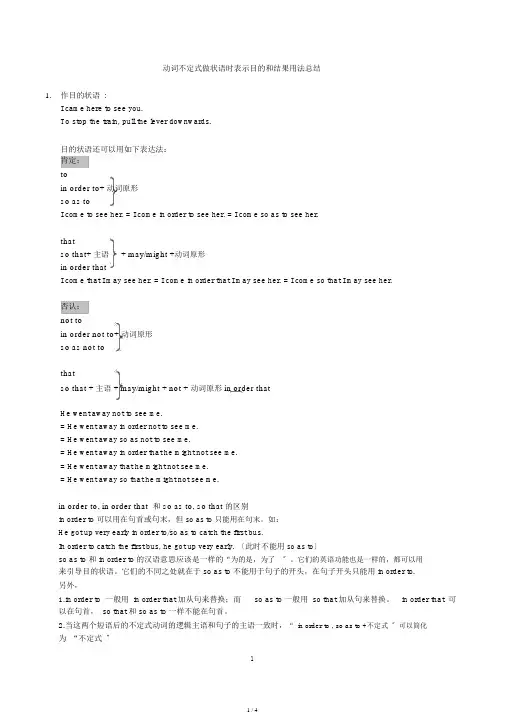
动词不定式做状语时表示目的和结果用法总结1.作目的状语 :I came here to see you.To stop the train, pull the lever downwards.目的状语还可以用如下表达法:肯定:toin order to+ 动词原形so as toI come to see her. = I come in order to see her. = I come so as to see her.thatso that+ 主语+ may/might +动词原形in order thatI come that I may see her. = I come in order that I may see her. = I come so that I may see her.否认:not toin order not to+ 动词原形so as not tothatso that + 主语 + may/might + not + 动词原形 in order thatHe went away not to see me.=He went away in order not to see me.=He went away so as not to see me.=He went away in order that he might not see me.=He went away that he might not see me.=He went away so that he might not see me.in order to, in order that 和 so as to, so that的区别in order to 可以用在句首或句末,但so as to 只能用在句末。
如:He got up very early in order to/so as to catch the first bus.In order to catch the first bus, he got up very early. 〔此时不能用so as to〕so as to 和 in order to 的汉语意思应该是一样的“为的是,为了〞。

PartⅡUsinglanguage——动词不定式作定语和结果状语Part ⅡUsing language——动词不定式作定语和结果状语【思维导图】⼀、基本特征感悟【感悟⽤法】①That football is such a simple game to play is perhaps the basis of its popularity.②He studied hard only to fail.【⾃我总结】句①中的to play是不定式,作game的定语。
句②中的to fail 是不定式,作结果状语。
⼆、主要⽤法精讲1.动词不定式作定语(1)动词不定式作定语常⽤来修饰名词或不定代词,放于所修饰的词后,为后置定语。
There is nothing to worry about.没什么可担⼼的。
The best way to raise money is to sell newspapers.筹集资⾦最好的⽅式是卖报纸。
(2)如果不定式动词与被修饰词之间有逻辑上的动宾关系,并且该动词是不及物动词,则需要加上适当的介词或副词使动宾关系成⽴。
When you move somewhere new,the first thing for you is to find a place to live in.当你搬到⼀个新的地⽅时,⾸先要找⼀个住处。
2.动词不定式作结果状语(1)动词不定式表⽰结果时,其逻辑主语就是句⼦的主语。
结果状语常常只限于learn(得知),find(发现),see,hear,to be told(被告知),make(使得)等具有界限含义的动词。
He returned home to learn his daughter had just been engaged.他回家后得知⼥⼉刚刚订婚了。
Dinosaurs have completely died out on the earth,never to be seen again.恐龙已经从地球上灭绝,将永不再被看到。

专题04重点语法复习:不定式作定语和结果状语▲动词不定式作定语动词不定式由“to+动词原形”构成。
这里的to是不定式标志,没有词义。
动词不定式作定语常用来修饰名词或不定代词,放于所修饰的词后,为后置定语。
这类名词有chance,way,opportunity,right(权利),dream,ambition,time,power,ability,attempt,promise,wish, plan,decision,tendency,failure等。
I am so busy that I have no time to inform him of the incident in detail.我是如此忙以至于我没有时间详细地告诉他这个事情。
【名师点津】(1)如果不定式的动词与被修饰词之间有逻辑上的动宾关系,并且该动词是不及物动词,则需要加上适当的介词或副词与前面的名词相呼应。
但place,time,way后不定式的介词常省略。
The Browns have a comfortable house to live in.布朗一家有一幢舒适的房子可以居住。
The old man is looking for a quiet place to live.那位老人正在找一个安静的地方住。
(2)序数词后常用不定式作后置定语。
Yang Yang is the first Chinese athlete to win a gold medal in the Winter Olympics.杨扬是中国第一个在冬奥会上获得金牌的运动员。
▲动词不定式作结果状语1.动词不定式表示结果时,其逻辑主语就是句子的主语。
结果状语常常只限于learn(得知),find(发现),see,hear,to be told(被告知),make(使得),turn out to be等具有界限含义的动词。
He returned home to learn his daughter had just been rescued.他回家后得知女儿刚刚被救了。

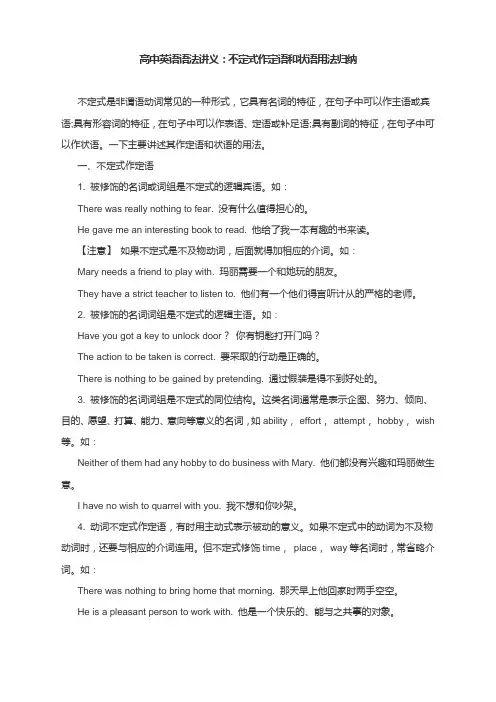
高中英语语法讲义:不定式作定语和状语用法归纳不定式是非谓语动词常见的一种形式,它具有名词的特征,在句子中可以作主语或宾语;具有形容词的特征,在句子中可以作表语、定语或补足语;具有副词的特征,在句子中可以作状语。
一下主要讲述其作定语和状语的用法。
一、不定式作定语1. 被修饰的名词或词组是不定式的逻辑宾语。
如:There was really nothing to fear. 没有什么值得担心的。
He gave me an interesting book to read. 他给了我一本有趣的书来读。
【注意】如果不定式是不及物动词,后面就得加相应的介词。
如:Mary needs a friend to play with. 玛丽需要一个和她玩的朋友。
They have a strict teacher to listen to. 他们有一个他们得言听计从的严格的老师。
2. 被修饰的名词词组是不定式的逻辑主语。
如:Have you got a key to unlock door?你有钥匙打开门吗?The action to be taken is correct. 要采取的行动是正确的。
There is nothing to be gained by pretending. 通过假装是得不到好处的。
3. 被修饰的名词词组是不定式的同位结构。
这类名词通常是表示企图、努力、倾向、目的、愿望、打算、能力、意向等意义的名词,如ability,effort,attempt,hobby,wish 等。
如:Neither of them had any hobby to do business with Mary. 他们都没有兴趣和玛丽做生意。
I have no wish to quarrel with you. 我不想和你吵架。
4. 动词不定式作定语,有时用主动式表示被动的意义。
如果不定式中的动词为不及物动词时,还要与相应的介词连用。

Unit 2. Using LanguageGrammar :Predicative clauses一.Learning Objectives:In this period, you are supposed to learn predicative clauses.二.Learning points and difficulties:Learn to use predicative clauses correctly三.Learning methods:1.Independent thinking2.Effective pair work and group work.3.Active Presentation四.Learning procedures:表语从句是指一个句子作为表语,放在系动词之后,说明主语是什么或者怎么样。
含有表语从句的复合句的一般结构为“主语+系动词+表语从句”,表语从句用陈述语序。
可接表语从句的系动词有be,look,seem,sound,appear 等。
as if /though引导的表语从句常置于系动词look,appear,sound,feel等后。
若表述真实的情况,就用陈述语气;若表述与客观事实相反的假设,则用虚拟语气。
Eg.It looks as if he benefits a lot from the project.看起来他好像从这个项目中获益不少。
(陈述语气)It looks as if /though he were drunk.他看上去好像喝醉了。
(虚拟语气)(2)表语从句的特殊句式The reason why...is that... ......的原因是......This/This/It is because... 这/那是因为......This/This/It is why... 这/那就是......的原因Eg. The reason why he didn’t e is that he had not received the invitation.他没来的原因是他没有收到请柬。
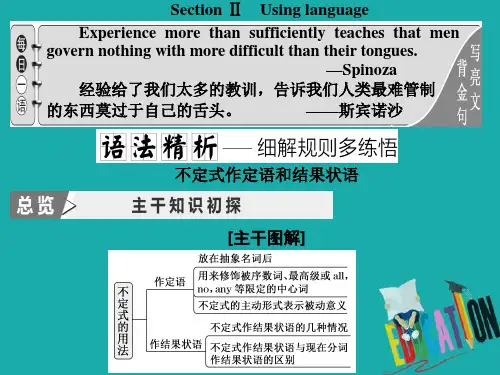

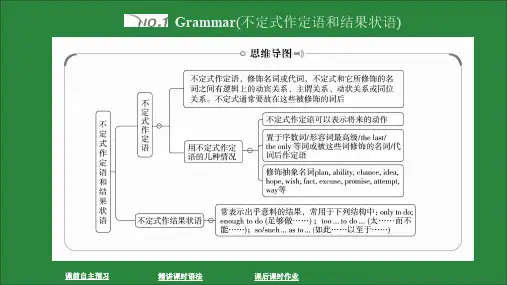
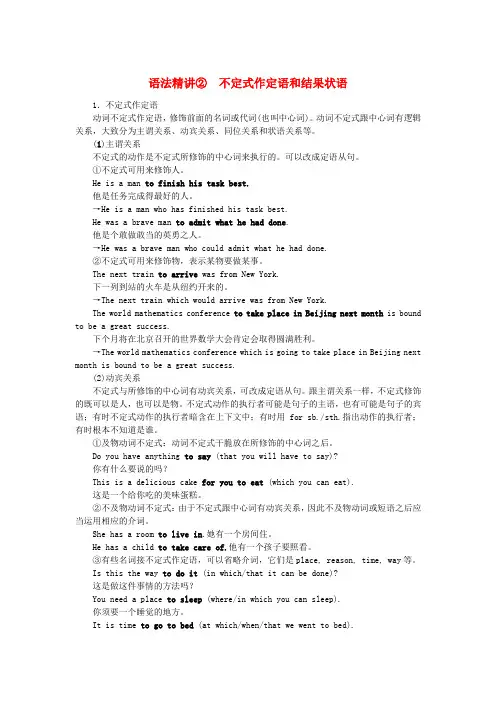
语法精讲②不定式作定语和结果状语1.不定式作定语动词不定式作定语,修饰前面的名词或代词(也叫中心词)。
动词不定式跟中心词有逻辑关系,大致分为主谓关系、动宾关系、同位关系和状语关系等。
(1)主谓关系不定式的动作是不定式所修饰的中心词来执行的。
可以改成定语从句。
①不定式可用来修饰人。
He is a man to finish his task best.他是任务完成得最好的人。
→He is a man who has finished his task best.He was a brave man to admit what he had done.他是个敢做敢当的英勇之人。
→He was a brave man who could admit what he had done.②不定式可用来修饰物,表示某物要做某事。
The next train to arrive was from New York.下一列到站的火车是从纽约开来的。
→The next train which would arrive was from New York.The world mathematics conference to take place in Beijing next month is bound to be a great success.下个月将在北京召开的世界数学大会肯定会取得圆满胜利。
→The world mathematics conference which is going to take place in Beijing next month is bound to be a great success.(2)动宾关系不定式与所修饰的中心词有动宾关系,可改成定语从句。
跟主谓关系一样,不定式修饰的既可以是人,也可以是物。
不定式动作的执行者可能是句子的主语,也有可能是句子的宾语;有时不定式动作的执行者暗含在上下文中;有时用for sb./sth.指出动作的执行者;有时根本不知道是谁。
专题04重点语法复习:不定式作定语和结果状语▲动词不定式作定语动词不定式由“to+动词原形”构成。
这里的to是不定式标志,没有词义。
动词不定式作定语常用来修饰名词或不定代词,放于所修饰的词后,为后置定语。
这类名词有chance,way,opportunity,right(权利),dream,ambition,time,power,ability,attempt,promise,wish, plan,decision,tendency,failure等。
I am so busy that I have no time to inform him of the incident in detail.我是如此忙以至于我没有时间详细地告诉他这个事情。
【名师点津】(1)如果不定式的动词与被修饰词之间有逻辑上的动宾关系,并且该动词是不及物动词,则需要加上适当的介词或副词与前面的名词相呼应。
但place,time,way后不定式的介词常省略。
The Browns have a comfortable house to live in.布朗一家有一幢舒适的房子可以居住。
The old man is looking for a quiet place to live.那位老人正在找一个安静的地方住。
(2)序数词后常用不定式作后置定语。
Yang Yang is the first Chinese athlete to win a gold medal in the Winter Olympics.杨扬是中国第一个在冬奥会上获得金牌的运动员。
▲动词不定式作结果状语1.动词不定式表示结果时,其逻辑主语就是句子的主语。
结果状语常常只限于learn(得知),find(发现),see,hear,to be told(被告知),make(使得),turn out to be等具有界限含义的动词。
He returned home to learn his daughter had just been rescued.他回家后得知女儿刚刚被救了。
Part ⅡUsing language——定语从句(3) 【思维导图】Ⅰ.基本特征感悟【感悟用法】The man to whom you talked just now is my English teacher.He is adopting a new teaching method in which we are all interested.Tomorrow is the Teachers’ Day on which we are going to give him a gift in order to thank him.【自我总结】上文中黑体部分引导的是定语从句,它们均为介词+关系代词。
Ⅱ.主要用法精讲一、“介词+关系代词”结构中的关系代词“介词+关系代词”是一种普遍使用的结构。
“介词+关系代词”结构中的关系代词只可用whom或which,不可用that。
Do you remember the day on which (when) you joined our club?还记得你加入我们俱乐部的那一天吗?In the dark street, there wasn’t a single person to whom she could turn for help.在漆黑的大街上没有一个人她能够求助。
二、“介词+关系代词”结构中介词的确定介词的选择可以总结为:“一先、二动、三意义、四特殊”。
1.一先,即先看先行词,从先行词入手。
介词往往和先行词构成固定搭配。
(比如时间常和on, in, by搭配;地点常用on,in,at;原因用for;方式用in,by,with 等)This is the house in which (where) the inventor lived.这就是那位发明家住过的房子。
2.二动,即看从句中的谓语动词结构。
根据从句中谓语动词的搭配选择合适的介词。
He is the person of whom everyone has heard.(hear of 听说)他是那位所有人都听说过的人。
考点串讲06 动词不定式作定语和结果状语非谓语动词概况非谓语动词即不能做谓语的动词,形式为以下为动词不定式的多种形式:1.不定式作定语不定式作定语通常置于所修饰的名词或代词之后,与所修饰的词之间构成逻辑上的主谓关系、动宾关系或同位关系。
(1)She is always the first to come and the last to leave .(主谓关系)She is always the first that comes and the last that leaves.她总是第一个到,最后一个离开。
(2)I can’t think of any good advice to give her.(动宾关系)I can’t think of any good advice that can be given to her我想不出任何好的建议给她。
(3)His last appeal, to come and see her, went unanswered.(同位关系)His last appeal, which is to come and see her, went unanswered没有人答应他最后要来看她的请求。
2.不定式作状语(1)作目的状语To enrich our school life, our school has organized various colorful after-class activities为了丰富我们的校园生活,学校已经组织了各种多彩的课后活动。
(2)only to do sth为不定式作结果状语,表示出乎意料的结果。
We hurried to the station,only to be told that the train had left.我们急匆匆地赶到车站,结果被告知火车已经开走了。
She went to the school in a hurry only to find it was Sunday .她匆忙赶到学校,结果发现今天是周日。